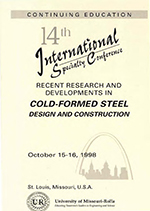Session Dates
15 Oct 1998
Abstract
The application of lightweight steel framing (LSF) in residential construction has been growing in the past few years and is bringing forth some issues in Cold Formed Steel Design Specifications that need to be addressed. The area of interest of this paper is the requirement for bearing stiffeners in both the CSA-SI36(1) Standard and the AISI(2) Specification. Specifically, both of these documents require that all cross-sectional elements of a bearing stiffener must be fully effective. This restriction is difficult to meet in practice since almost all LSF members are subject to local buckling, hence are no longer fully effective. A research project was carried out at the University of Waterloo where 82 web-stiffened tests were conducted on C-section joist specimens. This was a preliminary investigation to identify the basic behavior of these structural members. The web slenderness ratios of these sections varied from 196 to 281, with web depths of 203 mm (8 in.) to 356 mm (14 in.). Three types of stiffeners were investigated, i.e., a stud section, a track section and a fully effective bridging charmel section. Comparisons were made with earlier work of Phung & YU(3) upon which the current CSA-SI36(1) and AISI(2) design expressions are based. A number of issues relating to the behavior of these bearing stiffeners were investigated, resulting in the following conclusions: • The CSA-SI36(1) and AISI(2) design provisions for bearing stiffeners do not accurately predict the capacity of the stiffeners currently being used in LSF construction. The stiffener should be designed as either an eccentrically loaded column or an effective section with a reduced stress. The degree of eccentricity or stress reduction varies with the stiffener type and location on the joist. • The addition of extra screws connecting the stiffener to the joist web does not significantly increase the bearing capacity. • The interior bearing location has a greater resistance than at the end. • Locating the stiffener on the outside of the joist provides a slight increase in capacity in comparison to the stiffener being attached on the inside of the joist. • Allowing a 5 mm (3/16 in.) gap between the length of the stiffener and the depth of the joist does not appreciably affect the ultimate capacity, although the gap could have an effect on the serviceability of these assemblies.
Department(s)
Civil, Architectural and Environmental Engineering
Research Center/Lab(s)
Wei-Wen Yu Center for Cold-Formed Steel Structures
Meeting Name
14th International Specialty Conference on Cold-Formed Steel Structures
Publisher
University of Missouri--Rolla
Document Version
Final Version
Rights
© 1998 University of Missouri--Rolla, All rights reserved.
Document Type
Article - Conference proceedings
File Type
text
Language
English
Recommended Citation
Schuster, Reynaud M. and Fox, S. R., "Testing of Cold Formed Steel Floor Joists with Bearing Stiffeners" (1998). CCFSS Proceedings of International Specialty Conference on Cold-Formed Steel Structures (1971 - 2018). 4.
https://scholarsmine.mst.edu/isccss/14iccfsss/14iccfsss-session6/4
Testing of Cold Formed Steel Floor Joists with Bearing Stiffeners
The application of lightweight steel framing (LSF) in residential construction has been growing in the past few years and is bringing forth some issues in Cold Formed Steel Design Specifications that need to be addressed. The area of interest of this paper is the requirement for bearing stiffeners in both the CSA-SI36(1) Standard and the AISI(2) Specification. Specifically, both of these documents require that all cross-sectional elements of a bearing stiffener must be fully effective. This restriction is difficult to meet in practice since almost all LSF members are subject to local buckling, hence are no longer fully effective. A research project was carried out at the University of Waterloo where 82 web-stiffened tests were conducted on C-section joist specimens. This was a preliminary investigation to identify the basic behavior of these structural members. The web slenderness ratios of these sections varied from 196 to 281, with web depths of 203 mm (8 in.) to 356 mm (14 in.). Three types of stiffeners were investigated, i.e., a stud section, a track section and a fully effective bridging charmel section. Comparisons were made with earlier work of Phung & YU(3) upon which the current CSA-SI36(1) and AISI(2) design expressions are based. A number of issues relating to the behavior of these bearing stiffeners were investigated, resulting in the following conclusions: • The CSA-SI36(1) and AISI(2) design provisions for bearing stiffeners do not accurately predict the capacity of the stiffeners currently being used in LSF construction. The stiffener should be designed as either an eccentrically loaded column or an effective section with a reduced stress. The degree of eccentricity or stress reduction varies with the stiffener type and location on the joist. • The addition of extra screws connecting the stiffener to the joist web does not significantly increase the bearing capacity. • The interior bearing location has a greater resistance than at the end. • Locating the stiffener on the outside of the joist provides a slight increase in capacity in comparison to the stiffener being attached on the inside of the joist. • Allowing a 5 mm (3/16 in.) gap between the length of the stiffener and the depth of the joist does not appreciably affect the ultimate capacity, although the gap could have an effect on the serviceability of these assemblies.



